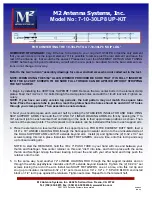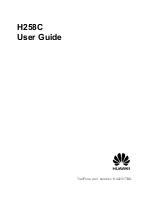
Page-16
BevFlex-4X Installation Manual Rev 2.23 November 2019
4.
EWE Antenna
The inverted EWE antenna was first described by Floyd Koontz, WA2WVL, and documented in the February 1995 edition
of QST. It is, by far, the smallest of the four receiving antenna variations possible with the BevFlex-4X system. The EWE
consists of a single wire element in an upside down “U” configuration, as shown below. The EWE is not a traveling wave
antenna like the Beverage and BOG, but is really a phased array of two, short, vertical, antennas that are top coupled by
the horizontal wire. The EWE antenna is a good performing, low frequency, receiving, reversible, antenna you can deploy
in a very small space. Each end of the EWE is fed back to the operating position with RG-6 coax. Like the Beverage and
the BOG, a four ft. ground rod must be installed at each end of the EWE.
The Terminator Unit internal jumpers must be configured for EWE use. The factory setting is for Beverage type antennas.
See Table-3 and Figure-19 and Figure 20 for more information on configuring the jumpers in the Termination Units
If the ground conductivity is poor, an additional wire connected between the ground rods and buried just beneath the
ground may help the performance of the EWE antenna. The box normally
used as a “feed point unit” for Beverage and
BOG installations is now used as an isolation transformer to maintain balance and eliminate ground loops. Note that the
coaxial feed-line connections to the switching control unit are reversed from the Beverage connections when the BevFlex-
4X is configured as a EWE or FLAG antenna system.
Figure-13 Typical Antenna Pattern for a 40 ft. x 10 ft. EWE (1.9 MHz)
Figure-14 EWE Antenna Block Diagram
3 dB Beam-width: 149.2°
Front to Back Ratio: 23.9 dB
Elevation Angle 32.0 deg.
Outer Ring -24.3 dB ref.
NEC-4 EZNEC Pro/4
















































